Introduction
Dishwashers date back to 1850. The first dish washers were huge contraptions that would accommodate many dishes at ago. These dish washers used steam power and were supplied with hot water. Later came various models that would hold dishes on cradles and rock them through water.
Later came, dish washers that had paddles that would slosh water on all sides of the dishes (Livens, 1924). Some had circular racks that would hold the dishes and rotate them in the water. In others dishes were held in racks and water would be circulated through them. 1875 saw C.E Hope-Vere invent the first water-jet dish washer.
Josephine Cochrane invented the modern dish washer in 1887. Though it was hand-powered, it was more advanced than the earlier inventions. Discovery of units installed with stable plumbing began in 1920 (Womack, Daniel & Roos, 1990). Miniature dish washers fit for household use were discovered by William Howard Livens in 1924.
Components of a dishwasher
A dish washer’s major constituents are made from plastic and steel. Its basic structure is made from steel as well as the door panel. This comes as prefinished coiled steel sheet.
The dishes’ rack is made of steel. It comes as coiled wire. These racks are coated with nylon or polyvinyl chloride (PVC) which prevents the dishes from being scratched.
Inside the dish washer is a tub that holds the washer arms and the rack in place. This tub is injection-molded in the dish washer using tablets of poly-propylene plastic- a strong plastic that does not react with chemicals found in detergents. It is also heat and water resistant.
Inside the door and behind the control panel is a control mechanism. This system controls sets time for every component of the cycle as well as activating the right function at the right time (Livens, 1924). For example it determines when to release the detergent, wash spray as well as when to drain. In more complex plant, the control mechanism is computerized. See the diagram below for a clear running dishwasher model.
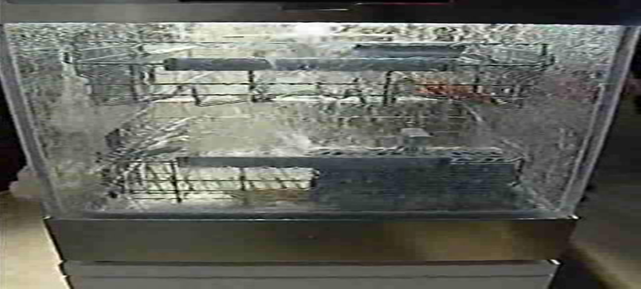
Intake valve
An intake valve brings water from the water supply into the dish washer. It functions by opening and allowing water pressure to drive water into the plant.
Pump
According to Davis (2009), a pump is powered by an electric motor. It is set up underneath the basin, right at the heart of the unit. Throughout the pump phase, this pump compels water into the spray jets. The pump diverts water into a drain tube during the drain phase. There are two types of pump:
A reversible pump switches between directing water into the spray jets and directing water into the drain by turning around the course of the motor. Reversible pumps are normally mounted vertically. A non-reversible pump on the other hand ensures water flows in a single direction.
The direction of water flow is exchanged from spray jet to drain by a solenoid that opens and shuts the suitable taps or exchanges one hose link to another (Womack, Daniel & Roos, 1990). These pumps are normally mounted horizontally. See the diagram below.

The crest spray arm is positioned above the dishes and sprays downwards, wetting the rear side of glasses and bowls in the crest rack. This is an improvement of the ring-shaped top rack that allowed impeller water from the bottom of the plant to rise above then fall on top of the dishes.
The spray arm is more efficient is more efficient as it cleans the rear side of the dishes allowing the enlargement of the higher rack so as to fill in the gap at the center of the spray area (Stamminger, 2003)..
Pop up spray tower
This extends upwards from the foot of the unit and uses the pressure of water to rise during washing sessions. Some units have a fixed tower spray arm instead of a pop up spray tower. The fixed tower spray is a middle level spray structure that allows huge spray-blocking items to be positioned in the lower rack and get water spurt up onto the base of dishes in the upper rack (Davis, 2009).
Fixed/ Spinning jets
These jets are found on the side walls of the washing section. The jets allow efficient cleaning of large dishes such as pots by turning them so as to face the walls and receive special cleaning from the jets.
Front door
The front door has a drop down feature with two or three racks that can be pulled out. These racks also known as baskets make the unit more efficient as the “pull-out” feature enable the user to remove or place dishes without having to stretch your hand deep in order to reach the far dishes(Livens, 1924).
The inside structure of the unit is made of plastic or stainless steel. Tubs made of stainless steel are resistant to hard water as well as more efficient in preservation of drying heat.
Hard food disposal components enable the plant to get rid of chunks of food particles in the washing water. However, this component is noisy and may be omitted. This means that the food particles should be removed before placing the dishes in the dish washer. Microprocessor controlled function helps in regulating the wash period to the amount of unclean items.
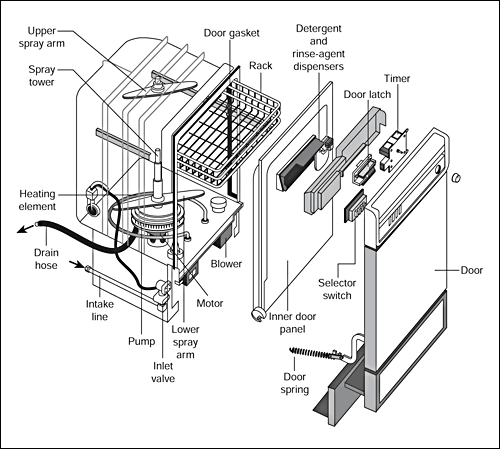
Bimetal Switch
This is a device that unlocks the detergent flap during the washing phase. A child lock-out device blocks children from opening the dish washer door while the cycle is running, thus avoiding accidents that may be caused by strong detergents or hot water.
The sound damping device helps in reducing the amount of noise during the wash sessions. The device is made of sound-absorbing materials like blankets. This may lower noise levels down to 39 decibels (Davis, 2009). Diagram below show an open dishwasher.
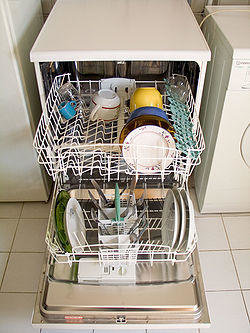
Dish washer detergents contain alkaline salts that fight and dissolve fats and oils; bleaching agents that break down and bleach natural sediments; anti-corrosion agents that protect dish washer elements from corrosion and phosphates that help dissolve magnesium and calcium ions thus avoiding lime-scale sediments.
However, these are not eco-friendly and are beginning to be phased out. The detergents also contain surfactants that are non-ionic in nature (Sharma et al., 2003). These surfactants protect the dishes from forming droplet spots when dry.
They also lower the water’s surface tension as well as emulsify fats, lipids and oils. Another component of dish washer detergents is enzymes that help in dissolving and breaking up food sediments that are protein in nature as well as lipids, fats and oils.
Rinse aids have surfactants that protect dishes from forming droplets while drying. A built-in water softener helps in removing magnesium and calcium ions. See the picture for a dish washer detergent tablet.
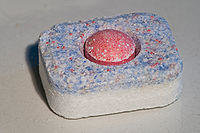
Dishwashers have a drying device that produces heat thus drying the dishes after the ultimate hot rinse. Incorporating a fan makes drying more efficient. Controlling levels of inventories for a dish washer’s components is necessary as it helps in maximizing profits in the manufacture of the unit (Livens, 1924).
This may be achieved by; replacing electromechanical rotary switch with a micro processor that uses a sensor. The microprocessor is cheaper and does not require a pressure switch as it has a motor sensor that senses the resistance of water. If it sense cavitations, then the amount of water is not optimal. See the diagrams below for commercial dish washers with dryers.
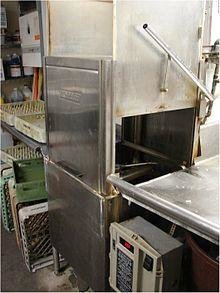
Commercial Hobart dish washer
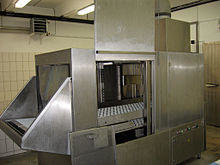
Commercial dish washer
A cheaper and more environment friendly way of controlling inventories is coating the inside of a dish washer with a glass reinforced polypropylene (GB266WG) that is detergent-resistant. This offers durability on the unit as well as cost effective benefits in the manufacture process of the plant.
It is light in weight as well as long-lasting. This enables it to endure violent surroundings within the dish washer. It is more resistant to detergents as compared to steel. It also augments the life span of other structural components of a dish washer such as frames (Stamminger, 2003). It reduces ageing results of oxygen, light as well as wear and tear caused by continued use.
GB266WG is more efficient in the manufacture process as it enables producers to lower inventories by using the one PP instead of different PP substances that are normally used in order to reduce the corrosive effect of detergents. This protects the unit from discoloration, loss of gloss, strength, flexibility or strength and scratching.
Its light weight enables easier holding and movement of the components as well as the finished product. It reduces energy use as it is made of plastic substance (Sharma et al., 2003). It reduces acoustic and thermal transmission thus lessening the call for detached insulation substances. This reduces costs of production further. Its stiff characteristic enables water tight link with other parts of the unit like frame.
An alternative method of reducing cost of production is lean manufacturing. This is eliminating wastes from a firm’s operations. Wastes in this case refer to any exploit or loss of assets that doesn’t lead to creation of a product directly. This type of manufacturing follows six steps of effective production. These are;
- Specifying worth from a customer’s point of view
- Noting all the significant stages necessary to bring the item to a customer
- Removing all the stages that do not add value
- Creation of a smoothly flowing process
- Pulling from the upstream process if flowing is impossible
- Continuing the process ensuring there are no waste products
Application of lean in the disposal of waste is highly cost effective in the manufacture process as it brings about efficiency in the initial stage. It helps in product refinement in order to add value. By eliminating waste, it saves time, labor and resources. This leads to production of high quality units thus reducing the need for repairs upon usage of the product.
An application of lean manufacturing of dish washers by G.E in 2009, resulted in reduction of inventories by 60%, improved labor efficiency by 30%, lowered time of production by 68% and reduced space of production (Stamminger, 2003). The low cost of production realized from lean manufacturing results in low selling price, attracting more customers and thus fetching higher profits.
References
Davis, C. B. (2009). The simplicity connection: creating a more organized, simplified and sustainable life. Victoria, USA: Trafford Publishing.
Livens, W. H. (1924). Improvements in apparatus for washing household crockery and the like. FR579765. UK: Intellectual Property Office.
Sharma, A., Jain, H., Carnali, J. O., Lugo, G. M. (2003). Influence of the manufacturing Process on corrosion behavior of soda-lime-silicate glassware. Journal of the American Ceramics Society, 86 (10), 1669.
Stamminger, R. (2003). A European comparison of cleaning dishes by hand. Proceedings of EEDAL conference.
Womack, J. P., Daniel, T. J. & Roos, D. (1990). The machine that changed the world. New York: Simon & Schuster.